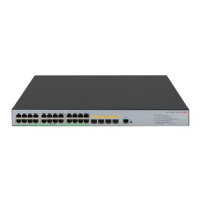36
Ste
Command
Remarks
3. Set the maximum number of
multicast groups that a port
can join.
igmp-snooping group-limit limit
[ vlan vlan-list ]
By default, the upper limit is 2000
for the S5500-EI switches, and
1000 for the S5500-SI switches.
Enabling multicast group replacement
For various reasons, the number of multicast groups that the switch or a port joins might exceed the upper
limit. In addition, in some specific applications, a multicast group that the switch newly joins must replace
an existing multicast group automatically. A typical example is channel switching. To view a new channel,
a user switches from the current multicast group to the new one.
To realize such requirements, you can enable the multicast group replacement function on the switch or
on a certain port. When the number of multicast groups that the switch or on the port has joined reaches
the limit, one of the following occurs:
• If the multicast group replacement feature is disabled, new IGMP reports are automatically
discarded.
• If the multicast group replacement feature is enabled, the multicast group that the switch or a port
newly joins automatically replaces an existing multicast group that has the lowest address.
IMPORTANT:
In the configuration, be sure to configure the maximum number of multicast groups allowed on a port (see
"Setting the maximum number of multic
ast groups that a port can join") before enablin
multicast
roup
replacement. Otherwise, the multicast group replacement functionality will not take effect.
Enabling multicast group replacement globally
Ste
Command
Remarks
1. Enter system view.
system-view N/A
2. Enter IGMP-snooping view.
igmp-snooping N/A
3. Enable multicast group
replacement.
overflow-replace [ vlan vlan-list ] Disabled by default
Enabling multicast group replacement on a port
Ste
Command
Remarks
1. Enter system view.
system-view N/A

